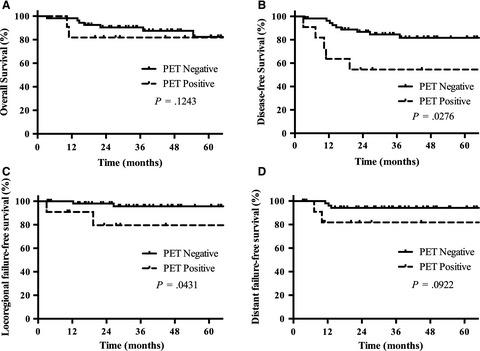当前位置:
X-MOL 学术
›
Cancer Med.
›
论文详情
Our official English website, www.x-mol.net, welcomes your feedback! (Note: you will need to create a separate account there.)
Hopkins criteria for residual disease assessment after definitive radiotherapy in nasopharyngeal carcinoma.
Cancer Medicine ( IF 4 ) Pub Date : 2019-12-25 , DOI: 10.1002/cam4.2790 Yang Liu 1 , Wen Long 2 , Guannan Wang 1 , Yuxiang Yang 2 , Biaoshui Liu 1 , Wei Fan 2
Cancer Medicine ( IF 4 ) Pub Date : 2019-12-25 , DOI: 10.1002/cam4.2790 Yang Liu 1 , Wen Long 2 , Guannan Wang 1 , Yuxiang Yang 2 , Biaoshui Liu 1 , Wei Fan 2
Affiliation

|
OBJECTIVES
Assessment of viable tumor residue after definitive radiotherapy is essential in patients with nasopharyngeal carcinoma (NPC). This study aimed to investigate the use of Hopkins criteria on positron emission tomography/computed tomography (PET/CT) for posttreatment response evaluation and whether plasma Epstein-Barr virus (EBV) DNA could bring additional value.
MATERIALS AND METHODS
NPC patients who underwent FDG-PET/CT scan within 26 weeks after definitive radiotherapy were retrospectively reviewed. Residual disease was evaluated by Hopkins 5-point score. Accuracy of Hopkins criteria before and after incorporating EBV DNA was calculated. Prognostic value for locoregional failure-free survival (LRFFS) and disease-free survival (DFS) was analyzed.
RESULTS
One hundred and sixteen patients were evaluated. Median follow-up time was 28.3 months (range 3.3-92.0 months). Residual disease was found in 19 (16.4%) patients. Overall, Hopkins criteria had high specificity (86.6%; 95% CI, 78.2%-92.7%) and negative prognostic value (NPV) (94.4%; 95% CI, 88.7%-97.3%), while sensitivity and positive prognostic value (PPV) was 73.7% (95% CI, 48.8%-90.9%), 51.9% (95% CI, 37.8%-65.6%), respectively. Posttreatment plasma EBV DNA was not predictive of residual tumor (P = .272). PPV and accuracy were 50.0% (95% CI, 32.1%-67.9%) and 83.0% (95% CI, 73.8%-90.0%) after incorporating detectable EBV DNA into the scoring system. Positive PET/CT results were significantly correlated with inferior 3-year LRFFS (95.7% vs 79.5%, P = .043) and 3-year DFS (84.6% vs 54.4%, P = .028).
CONCLUSIONS
The Hopkins criteria demonstrated high NPV and specificity in posttreatment assessment, with the potential to be a reliable prognostic indicator for locoregional failure. Combining EBV DNA with PET/CT did not improve diagnostic accuracies. PET/CT should not be performed less than 12 weeks after treatment.
中文翻译:

鼻咽癌明确放疗后残留疾病评估的霍普金斯标准。
目的对鼻咽癌(NPC)患者进行彻底放疗后评估存活肿瘤残留至关重要。这项研究旨在研究霍普金斯标准在正电子发射断层扫描/计算机断层扫描(PET / CT)上用于治疗后反应评估的可能性,以及血浆爱泼斯坦-巴尔病毒(EBV)DNA是否可以带来附加价值。材料与方法回顾性分析确定放疗后26周内接受FDG-PET / CT扫描的NPC患者。通过霍普金斯5分评分评估残留疾病。计算合并EBV DNA前后霍普金斯标准的准确性。分析了局部无衰竭生存期(LRFFS)和无疾病生存期(DFS)的预后价值。结果对116例患者进行了评估。中位随访时间为28。3个月(范围3.3-92.0个月)。在19(16.4%)位患者中发现了残留疾病。总体而言,霍普金斯标准具有高特异性(86.6%; 95%CI,78.2%-92.7%)和阴性预后价值(NPV)(94.4%; 95%CI,88.7%-97.3%),而敏感性和阳性预后价值( PPV)分别为73.7%(95%CI,48.8%-90.9%),51.9%(95%CI,37.8%-65.6%)。治疗后血浆EBV DNA不能预测残留肿瘤(P = .272)。将可检测的EBV DNA纳入评分系统后,PPV和准确度分别为50.0%(95%CI,32.1%-67.9%)和83.0%(95%CI,73.8%-90.0%)。PET / CT阳性结果与较低的3年期LRFFS(95.7%比79.5%,P = .043)和3年期DFS(84.6%比54.4%,P = 0.028)显着相关。结论霍普金斯标准在治疗后评估中显示出较高的NPV和特异性,有可能成为局灶性衰竭的可靠预后指标。EBV DNA与PET / CT结合使用并不能提高诊断准确性。治疗后不得少于12周进行PET / CT。
更新日期:2019-12-26
中文翻译:

鼻咽癌明确放疗后残留疾病评估的霍普金斯标准。
目的对鼻咽癌(NPC)患者进行彻底放疗后评估存活肿瘤残留至关重要。这项研究旨在研究霍普金斯标准在正电子发射断层扫描/计算机断层扫描(PET / CT)上用于治疗后反应评估的可能性,以及血浆爱泼斯坦-巴尔病毒(EBV)DNA是否可以带来附加价值。材料与方法回顾性分析确定放疗后26周内接受FDG-PET / CT扫描的NPC患者。通过霍普金斯5分评分评估残留疾病。计算合并EBV DNA前后霍普金斯标准的准确性。分析了局部无衰竭生存期(LRFFS)和无疾病生存期(DFS)的预后价值。结果对116例患者进行了评估。中位随访时间为28。3个月(范围3.3-92.0个月)。在19(16.4%)位患者中发现了残留疾病。总体而言,霍普金斯标准具有高特异性(86.6%; 95%CI,78.2%-92.7%)和阴性预后价值(NPV)(94.4%; 95%CI,88.7%-97.3%),而敏感性和阳性预后价值( PPV)分别为73.7%(95%CI,48.8%-90.9%),51.9%(95%CI,37.8%-65.6%)。治疗后血浆EBV DNA不能预测残留肿瘤(P = .272)。将可检测的EBV DNA纳入评分系统后,PPV和准确度分别为50.0%(95%CI,32.1%-67.9%)和83.0%(95%CI,73.8%-90.0%)。PET / CT阳性结果与较低的3年期LRFFS(95.7%比79.5%,P = .043)和3年期DFS(84.6%比54.4%,P = 0.028)显着相关。结论霍普金斯标准在治疗后评估中显示出较高的NPV和特异性,有可能成为局灶性衰竭的可靠预后指标。EBV DNA与PET / CT结合使用并不能提高诊断准确性。治疗后不得少于12周进行PET / CT。



























 京公网安备 11010802027423号
京公网安备 11010802027423号